-
Documentation
-
About
- Getting Started & Use Cases
- Support
-
What's New
- Simplified tools for designing with contour lines
- DynamicFlood: Organize and understand your computations
- Modelling stormwater networks in Scalgo Live
- National US high-resolution land cover map
- New functionality for CAD users!
- DynamicFlood: Cleaning up rain events and adding historical rains, now available in France
- National Polish high-resolution land cover map
- DynamicFlood now available in Great Britain
- Global contour maps now available
- Updated Swedish topsoil map
- Scalgo Live Global theme is updated with new elevation and land cover data
- Detailed culvert information in DynamicFlood
- No more Lantmäteriet fees for Swedish data
- Depth-dependent surface roughness (Manning) in DynamicFlood
- Detailed land cover map for all of Great Britain
- National French high-resolution land cover map
- Work with multiple features simultaneously in the canvas
- Spill points on flash flood map and depression map
- New surface roughness (Manning) parameters for DynamicFlood
- Workspace and Modelspace sharing updates
- Regionally varying rain in DynamicFlood Sweden
- Veden imeytyminen nyt osana rankkasadeanalyysejä
- Use Scalgo Live anywhere in the world
- DynamicFlood: Live model speed info and regionally-varying rain events
- Sea-level rise: Download building flooding information
- Detailed contour maps and editable buildings in Workspaces
- New in Modelspaces: Explore hydrodynamic simulations and visualise the dynamics of flow velocity
- National German high-resolution land cover map
- Specify basins and protrusions by drawing their outer boundary
- Simplified path features
- National Norwegian high-resolution land cover map
- Organise and communicate on a digital canvas
- New sidebar to help organize your analyses and queries
- Sliding contours
- Ny skyfallsanalys och en ännu bättre marktäckekarta
- New land cover map for Finland
- Depths in the depression map
- New Danish land cover map with more classes
- National Swedish High-Resolution Impervious Surface Mapping
- Watershed tool updated with even better descriptions of catchment characteristics
- National Flash Flood Map with Infiltration and Drainage for Denmark
- Add your own WMS layers to SCALGO Live
- Enriched building data in Denmark
- National hydrological corrections and Land Cover for Poland
- National hydrological corrections for Norway
- Updated Impervious Surface Mapping for Denmark
- National hydrological corrections and updated local data for Finland
- Fast and intuitive tools to work with infiltration and land use
- Improvements to vector imports and exports
- National Danish groundwater model
- New Sweden high-resolution model
- New powerful depression map and more analyses visualization options
- Introducing Modelspaces: Get your hydrodynamic models into SCALGO Live
- Use case videos
- Access a EA flood maps inside SCALGO Live
- Improved map export
- New powerful ways to edit the elevation model
- Better coloring of flooding layers and sea-level depth filtering
- National Danish High-Resolution Impervious Surface Mapping
- National access for local and regional organizations
- Simpler, more powerful downloads
- Customize Layer Transparency
- Hydrological corrections and new data in Sweden
- Improved export functionality
- Access a wide range of authorative data inside SCALGO Live
- Importing VASP data
- Measure gradients, undo edits, and Norway updates
- New terrain edit features, soil balance information and much more...
- Browse historical orthophotos in SCALGO Live
- Emergency planning with sea-level rise from national forecast data
- Detailed information about watershed composition
- Better styling of imported vector layers
- New Danish Elevation Model
- Work with gradients in the profile widget
- Flood risk screening from rivers and flow paths
- New workspace tool: Raise and lower terrain uniformly
- Importing LandXML TINs, LAS point clouds
- New model in Sweden
- Side slopes on workspace features
- Drag and drop enhancements
- Swedish contour maps
- Subsurface basins and sewage drains in workspaces
- New Interface
- Volume information for watersheds and flow paths
- New powerful tool for emergency response and coastal flood prevention
- Denmark: New flash flood map
- Sweden: Geodatasamverkan setting for Swedish users
- Import custom terrain models
- New Hydrological Corrections
- Elevation contours now available
- Download orthophotos as JPEG and PNG
- Subsurface structures in workspace
- Sea-levels in terrain profiles
- Updated orthophotos
- Models and analysis update
- User interface updates
- User interface updates
- GeoDanmark/FOT data, Matrikelkortet now available
- New flash flood map
- Download of risk polygons
- Updated orthophotos
- Nationwide hydrology on the new DHM/2015 model now available
- New flash flood map computation available with watershed download
- DHM/2015 variants and sea-levels now available nationwide
- DHM/2015 now available nationwide
- Hydrology on the new DHM/2015 model now available
- New DHM/2015 Model - now with buildings
- New DHM Model
- Watershed Tool
- Ad hoc layers
- Nationwide contour maps for all countries
- Single Sign-On
- Data Fees
- User Interface
- Canvas
- Analysis
- Workspaces
- Modelspaces
- Working with CAD data
- Core+ DynamicFlood
- Core+ NatureInsight
- Streams and Flow
- Physical Properties
- Country Specific
-
About
Country Specific – Denmark
Quick Facts about the Danish model (DHM)
| Cell Size | 40x40 cm |
| Coordinate System | ETRS89 / UTM 32N |
| Vertical Reference | DVR90 |
| Flight Years | 2019–present |
Our Danish elevation model is based on the official Danish elevation model (also known as DHM) produced by the Agency for Climate Data (KDS). Since 2018, KDS updates the elevation model in partial increments of about a fifth of the country every year. The model has a horizontal resolution of 0.4 m and was released for the first time in this resolution in 2015, improving upon the previous model from 2007, which had a resolution of 1.6 m. The model is available in Scalgo Live under the name Terrain (Terræn). There are a couple of different variants of the model available.
Terrain/Buildings (Terræn/Bygninger): This is the raw model enriched with building footprints from the national GeoDanmark data set. For each GeoDanmark building footprint, we've raised the elevation of the cells there are inside the buildings with 10 m, relative to the highest elevation value of the original terrain model.
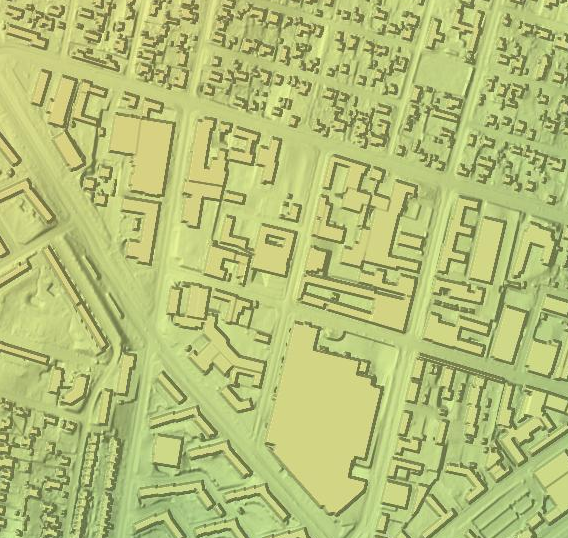
Terrain/Buildings/Rain (Terræn/Bygninger/Regn) and Terrain/Buildings/Sea (Terræn/Bygninger/Hav): Both models are derived from the Terrain/Buildings model and include the set of hydrological corrections from GeoDanmark.
Terrain/Buildings/Rain includes the corrections made for modeling water flowing downstream on the terrain, e.g., water from rain events. Terrain/Buildings/Sea is targeted for modeling flooding from sea. The main difference between the two models is infrastructure like sluices, and whether they are open or closed.
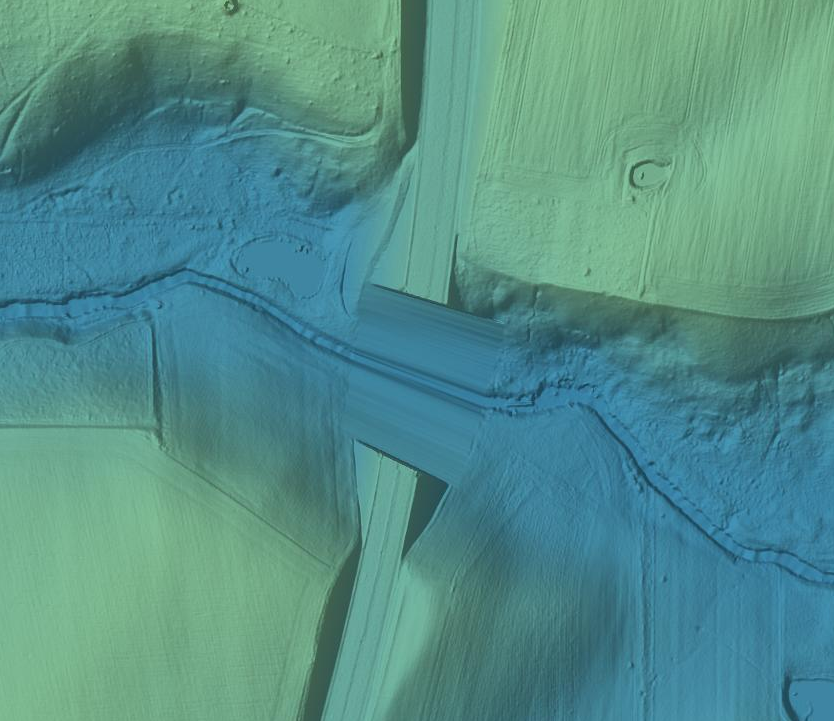
Surface (Overflade): This is the Digital Surface Model (DSM) version of the DHM. In this model houses, vegetation etc. is preserved in the elevation model.

Sources: A source layer, showing the acquisition year of the data, is available by clicking the gear icon next to an elevation layer and selecting the "Source" ("Kilde") tab, and then "Show source information" ("Vis kildedata"). Use it to figure out how old the data is for your project area. You can use the point query tool to get the acquisition year for a particular area.
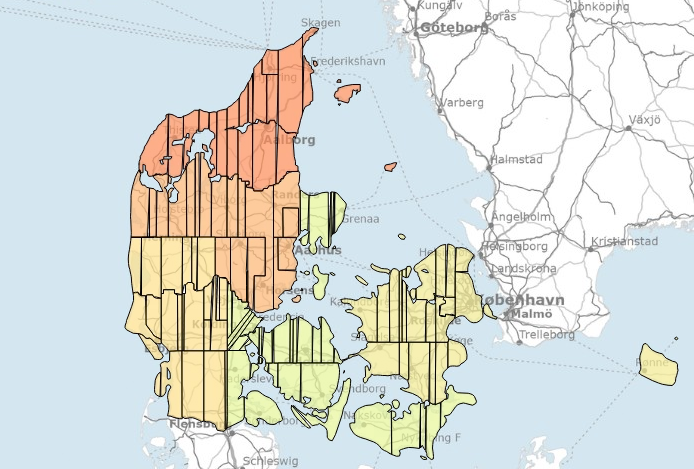
Terrain (2018-2022) (Terræn (2018-2022)):
This is a historical version of DHM, released in 2023 based on scans from 2018-2022.
Surface (2018-2022) (Overflade (2018-2022)):
This is the Digital Surface Model (DSM) version of DHM from 2018-2022.
Terrain (2015) (Terræn (2015)):
This is a historical version of DHM, released in 2015 based on scans from 2014-2015. It was the first model released by KDS with a resolution of 0.4 m.
Surface (2015) (Overflade (2015)):
This is the Digital Surface Model (DSM) version of DHM from 2015.
Terrain (2007) (Terræn (2007)):
This is an older model of Denmark released in 2007 based on scans from 2005-2007. It has a horizontal resolution of 1.6 m.
Surface (2007) (Overflade (2007)):
This is the Digital Surface Model (DSM) version of DHM from 2007.
Terrain (QuickDHM) (Terræn (QuickDHM)):
This is a temporary version of DHM with the newest available data from KDS. Is have not been quality checked and errors and missing data occurs. It has a horizontal resolution of 0.4 m.
Surface (QuickDHM) (Overflade (QuickDHM)):
This is the Digital Surface Model (DSM) version of QuickDHM.
Soil type (Jordtypekortet)
Scalgo Live includes a map of topsoil types in Denmark which is based on a national map of soil types, known as Jordtypekortet, from the Department of Agroecology at Aarhus University. Jordtypekortet classifies the soils of Denmark into types based on analyses of soil samples taken mainly from farmland. For more information on the original data, please read the information provided for the layer in the Library. Since the latest version of the map does not include data for impervious areas, we start by filling in the gaps using a nearest-neighbor method. Hereafter, we enhance the map using our land cover map and polygons areas that have a drainage system. For further details on this step, please see the soil type section.
Land Cover (Arealdække)
Scalgo's land cover map is available in Denmark. It is produced in 20cm resolution, based on the national orthophoto provided KDS and a few auxiliary sources. For information on the data that went into the most recent land cover map, please read the information provided for the layer in the Library. For more information about how the land cover data is produced and used, please refer to the land cover documentation.
Infiltration and drainage to sewers
The Flash Flood Map supports the use of runoff functions to specify the runoff generated from each cell as a function of the rain depth. In Denmark we have produced a national Flash Flood Map where we use runoff functions to include infiltration and drainage to sewers in the model. When you enable infiltration and drainage in the Flash Flood Map, the infiltration at a cell is determined by the cell’s land cover class, as well as its soil type (in natural areas) and sewer map status (in artificial areas).
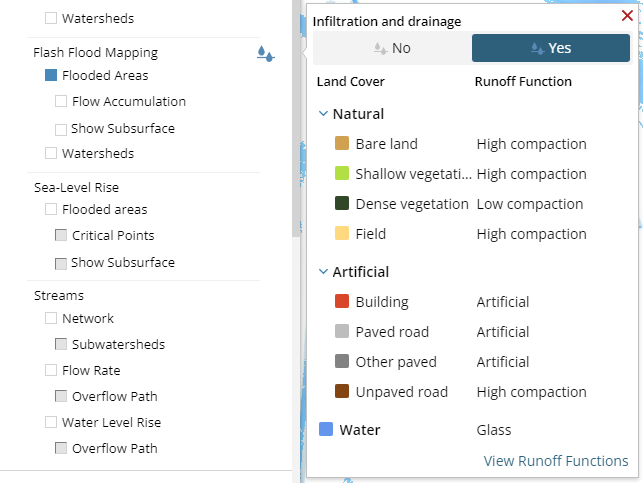
In artificial areas, if a cell is in an area that has any kind of sewer system, then we apply a CN-p-curve that represents the capacity of an average Danish sewer system. Other impervious areas use the glass model with no initial loss, i.e. all rainfall is turned into runoff.
In natural areas, dense vegetation areas are assumed to have loose soil, while shallow vegetation and bare land areas are assumed to have compacted soil. Each soil type in the topsoil map has a CN-p-curve for both compact and loose conditions.
For more information about the Flash Flood Map with infiltration and drainage, including information about parameter settings and CN-p-curve numbers, we refer to our in-depth white-paper.
To view the runoff functions used for individual soil types, click “View Runoff Functions” in the infiltration and drainage popup.
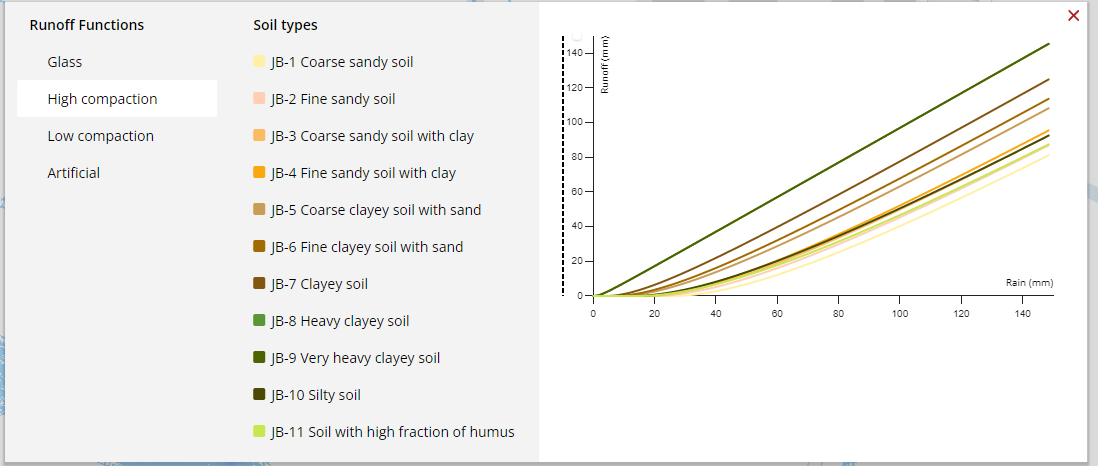
If you want to investigate the sewer type mapping and the soil type data used in the computation you can find them both in the library.

Rain events
In the Core+ module DynamicFlood, Scalgo Live provides a set of design rain events with varying return periods for use in the simulations. The rain events for a given workspace are selected based on the location of the workspace from a grid of IDF parameters (5 x 5 km2) which we created using data and recommendations from "skrift 32" and accompanying spreadsheet provided by Spildevandskomitteen. The rain events were created following the Chicago Design Storm method.
Urban and sewered areas
To determine whether an area is to be considered sewered (affecting the fate of rainfall on artificial surfaces in the Flash Flood Map with infiltration, see above, and the fate of all water on artificial surfaces in DynamicFlood) we use the map "Kloakoplande - Vedtaget" from Plandata.dk (can be found in the Library). We assume that all artificial surfaces that fall within a polygon of in this map are connected to a drainage system (no matter what the status specified for the polygons in the map), and that all artificial surfaces that fall outside these polygons are not connected to a drainage system.
We set the maximum capacity of the drainage system in DynamicFlood in Denmark to 36 mm/hr. This value was chosen to reflect common historical dimensioning practice in Denmark.
To determine whether an area is to be considered urban (affecting some soil types in the topsoil map), we use the same map as for sewered areas.